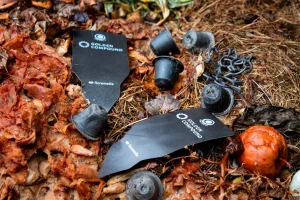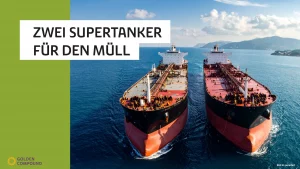Polybutylene Succinate (PBS) – A Sustainable Plastic with Future Potential
Global plastic pollution is one of the greatest environmental challenges of our time. To address this issue, innovative materials are needed—ones that are both high-performing and eco-friendly. One such material is Polybutylene Succinate (PBS). This biodegradable plastic offers a promising alternative to conventional plastics such as polyethylene (PE) or polypropylene (PP).
PBS stands out due to its high heat resistance (up to >90°C), good impact strength, and excellent processability. These characteristics make it suitable for a wide range of applications, including food packaging, plant pots, and technical components. At the same time, PBS impresses with its biodegradability: at the end of its lifecycle, the material is broken down by microorganisms into water, biomass, and carbon dioxide—leaving no harmful residues behind.
PBS’s biodegradability even surpasses that of other bioplastics such as PLA (polylactic acid), making it an important solution in reducing plastic waste and contributing to environmental protection.
How is PBS produced?
The “Cooking Process” (Polycondensation):
PBS production occurs in two main steps, known as polycondensation:
Step 1: Mixing and Heating (Esterification) Succinic acid and 1,4-butanediol are mixed in a special reactor equipped with a mechanical stirrer and inert gas (e.g., nitrogen) to prevent oxidation. The mixture is gently heated to 160–190°C. During this initial phase, the monomers start forming short chains, releasing water vapor as a byproduct—much like steam during cooking.
Step 2: Building Long Chains (Polycondensation) The temperature is then raised to 220–240°C, enabling the formation of long, stable polymer chains. Imagine this as connecting many small LEGO bricks into a long, flexible chain—this happens on a molecular level. Achieving high molecular weights is essential for strong mechanical properties. However, conventional polycondensation may cause degradation processes that hinder chain formation. To prevent this and speed up the reaction, catalysts—commonly titanium-based compounds—are added.
Where Do the Raw Materials Come From?
The origin of succinic acid and 1,4-butanediol significantly influences the environmental footprint of PBS:
- Fossil Resources: Traditionally, these chemicals can be derived from petroleum, natural gas, or coal—similar to many conventional plastics.
- Plant-Based Biomass: A more environmentally friendly method is to use renewable plant resources, such as sugars or starches from corn, sugarcane, or cassava. This approach makes PBS biobased and significantly improves its sustainability.
Biobased PBS
A “biobased” plastic means its raw materials come from living organisms—particularly renewable biological resources like plants, rather than fossil fuels. In practice, the biobased content of Bio-PBS is typically around 70%, due to a combination of economic and technical factors:
- Cost Factors: While bio-based BDO production from plants is technically feasible, it remains nearly twice as expensive as fossil-based BDO. For companies competing on price, this presents a significant challenge.
- Efficiency and Scalability: Although biobased production methods are improving, fossil-based production remains more efficient and better suited for high-volume industrial output.10 Petro-based PBS is sometimes considered more "pure" and ideal for large-scale, continuous processes.
Even if one component, like succinic acid, is 100% biobased, the other—BDO—may still be partially or entirely fossil-based. This "blending" balances environmental goals with cost efficiency and production realities. However, experts predict that fully biobased PBS will become price-competitive in the near future as demand grows and technology advances.
Recycling and Circular Economy
In addition to being biodegradable, PBS can also be chemically recycled—breaking the material down into its original monomers for reuse. Think of taking apart the LEGO chain back into individual bricks. Mechanical recycling is also viable if done in closed-loop systems. However, repeated cycles can degrade quality, resulting in shorter and more worn LEGO chains over time.
Both recycling methods support a circular economy,helping to minimize waste and maximize resource reuse.

The Path to 100%: Making PBS Even Greener
The long-term goal is to produce 100% biobased PBS at competitive prices—making it an even more sustainable solution.
To achieve this, several developments are underway:
- Smarter Microorganisms Researchers are engineering high-performing microbes to convert plant sugars into succinic acid and BDO more efficiently. These “super-microbes” could revolutionize the fermentation process.
- Lower Production Costs: As technology improves and large-scale biorefineries increase production, costs will decrease, making fully biobased PBS more commercially viable.
- Broader Feedstock Base: Scientists are exploring the use of non-food biomass like wood chips, straw, and agricultural residues (lignocellulose) to reduce dependence on food crops and improve overall sustainability.
- Policy and Regulation: Governments can drive adoption by offering incentives or setting quotas for biobased content. Regulatory support is crucial to push the market toward fully renewable materials, especially when cost alone isn’t enough to shift demand.
Why Golden Compound Chooses PBS
At Golden Compound, we deliberately use Bio-PBS as the foundation for many of our GC green formulations. Not just because of its sustainability—but because of its excellent processing and performance characteristics. Our customers appreciate PBS because it behaves much like conventional plastics, yet is biodegradable at the end of its life.
A Bonus Sustainability Factor: Sunflower Seed Shells
Our GC green product line takes sustainability even further by incorporating sunflower seed shells—a byproduct of the food industry that would otherwise go to waste. By using this natural material as a filler, we not only create a unique natural look and feel, but also conserve valuable resources.
This combination—Bio-PBS as a biobased matrix and sunflower seed shells as a natural filler—makes our GC green materials especially sustainable. They are biodegradable, durable, and versatile, suitable for applications such as plant pots, packaging, and more.
The Benefits of GC green at a Glance:
- Excellent processability – perfect for injection molding, extrusion, and thermoforming
- Flexible formulations,including options with 100% biobased PBS upon request
- Natural fillerslike sunflower seed shells or mineral additives to reduce resource use
- High thermal resistance and strong mechanical properties
- Biodegradable and recyclable in closed-loop systems
Bio-PBS as a Key to a Greener Future
Polybutylene succinate is much more than an alternative to traditional plastics. It’s a material that perfectly blends sustainability and functionality. With our GC green materials, we go one step further: combining Bio-PBS with renewable raw materials like sunflower seed shells, we offer innovative, eco-conscious solutions for the needs of today and tomorrow.
By choosing products made from Bio-PBS, you are actively contributing to environmental protection and supporting the shift toward a resource-efficient circular economy.




